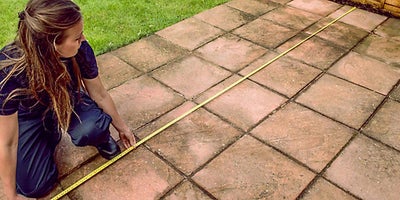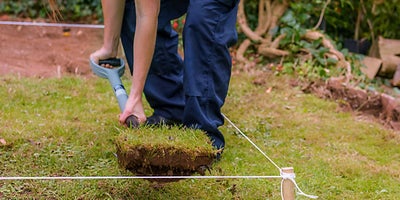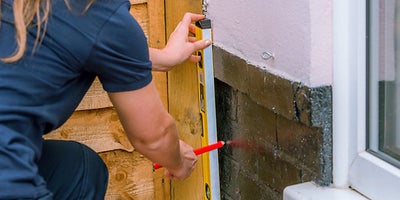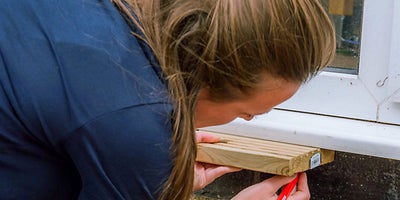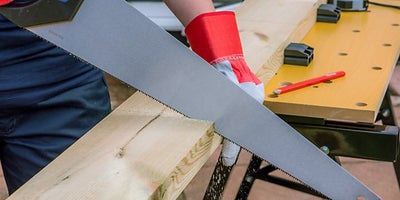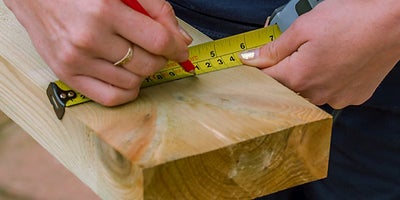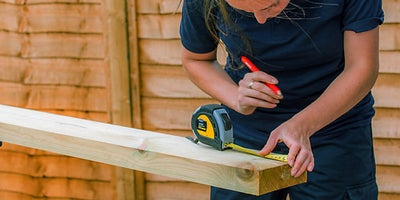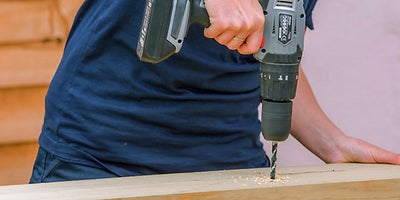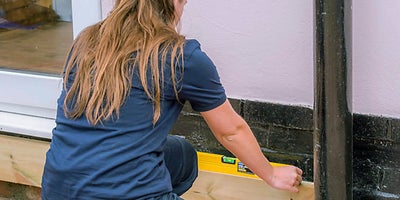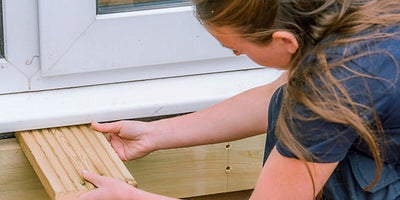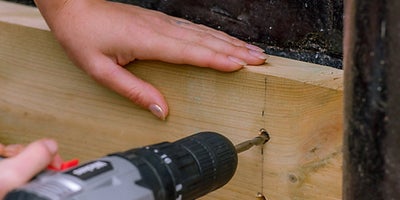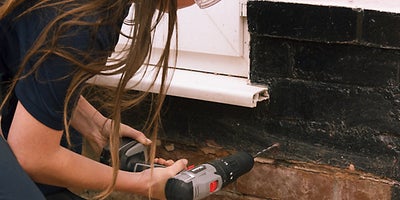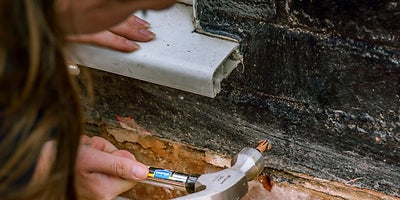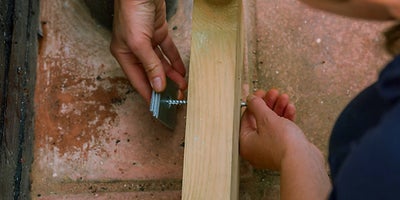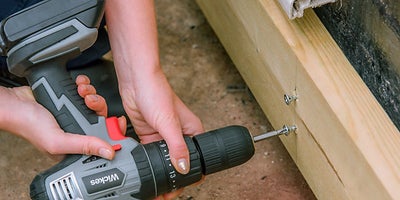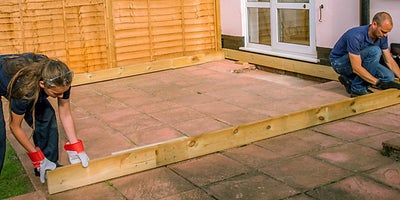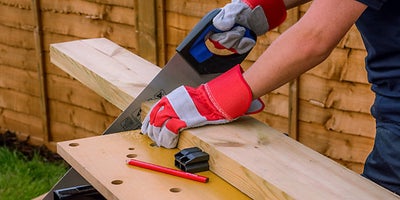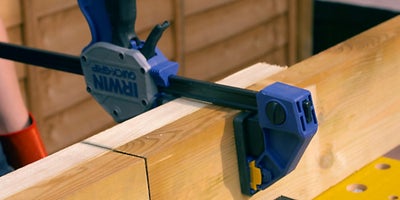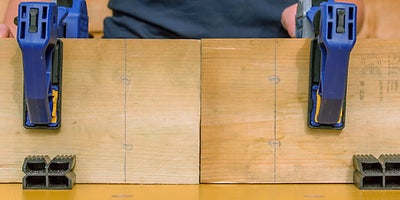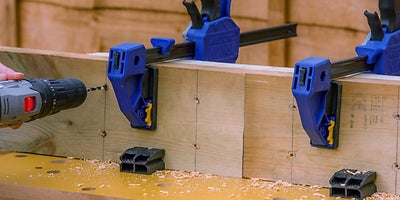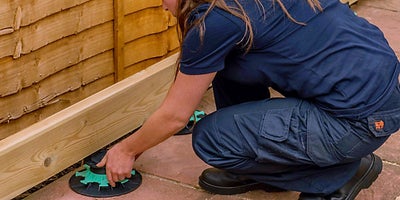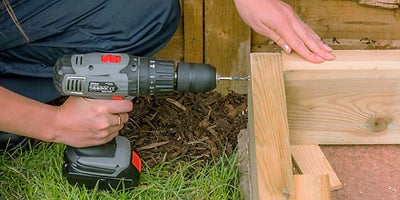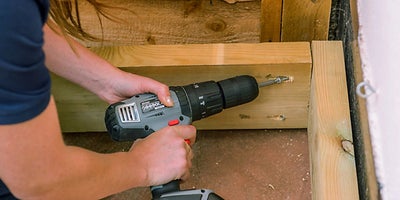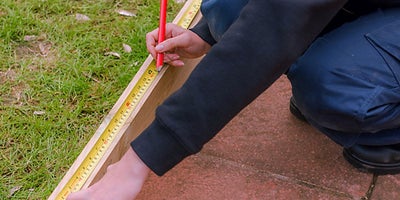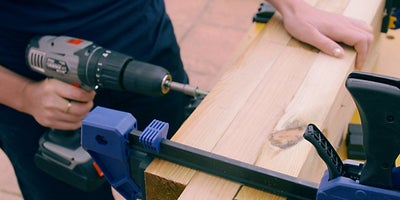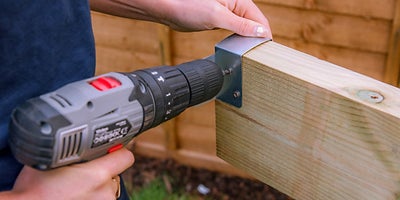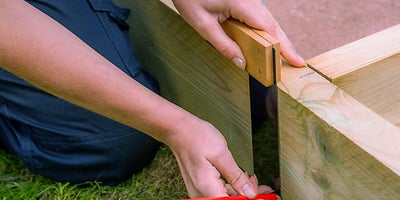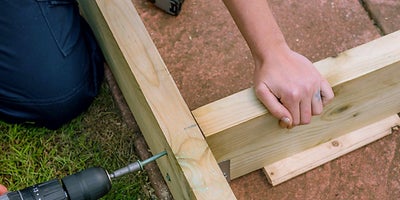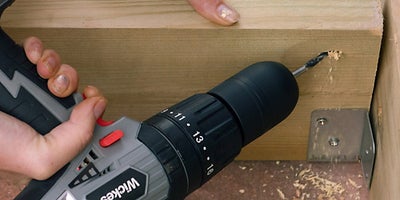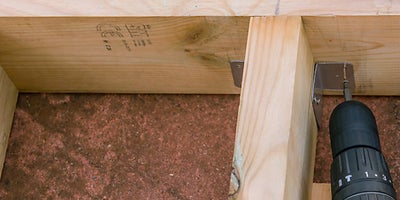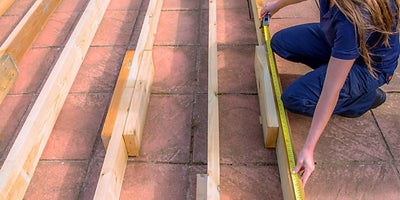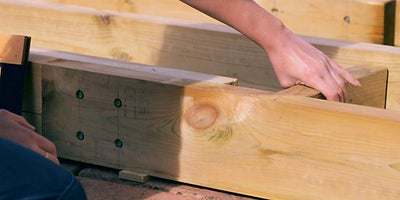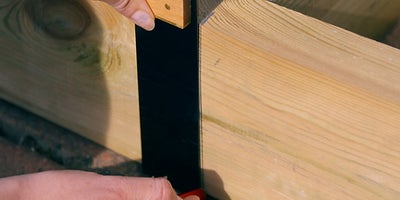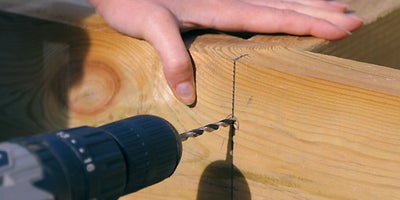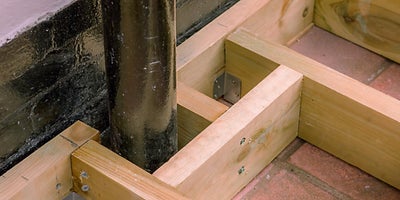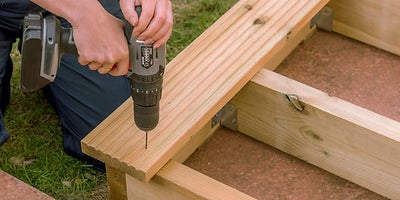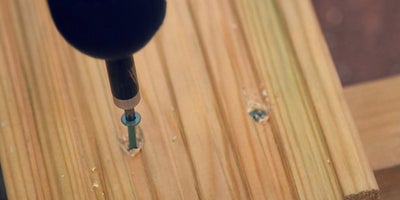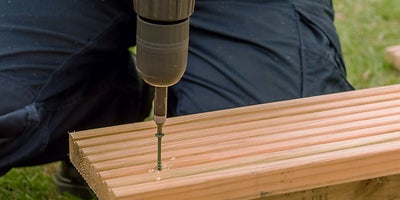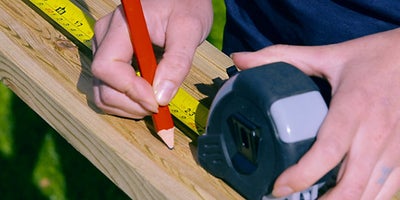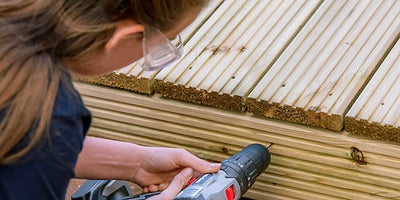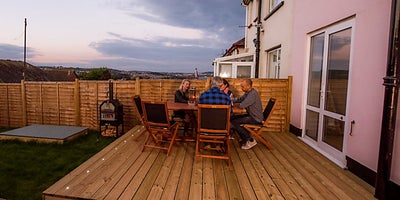Installing garden decking
Installing decking is an excellent way to create a space in your garden which can be used for relaxing and entertaining. Decking can either be freestanding or attached to your house, and it really gives you a chance to be creative with design and function. A single level deck is relatively straightforward to plan and build. A more complex decking project would include features such as balustrades, railings and steps.
This guide outlines the method for building a single level deck with timber frame and installing it on a patio next to a house. But depending on your plans, decking can also be a freestanding structure anywhere in your garden.
Where should I build my decking?
The size and location of your deck will be linked to its function – are you planning an area for entertaining, for BBQing, or perhaps you want a children’s play area? Are you installing it to complement other garden features such as paving or turf? Consider how big you need the decking to be when you’re deciding a location. If in doubt then be conservative – you can always extend in the future.
There are a few other factors to think about when planning your decking:
- Is the ground level or does it have a noticeable slope?
- How much sun will the decking get, and what’s the view like from the site?
- How much privacy will you have?
- Is the ground dry underfoot? Wet or boggy ground isn’t suitable for decking.
- Are there any existing features to work around such as trees and posts?
Carefully plan your decking layout and try to limit cutting and wastage. Take into account the following:
- The material of your deck boards
- The size of your decking area
- The size (length and width) of deck boards you’re using
- The required expansion gap for your deck boards
How far apart should decking boards be?
Expansion gaps are essential when constructing decking. The gap between each individual deck board allows for rainwater runoff, plus the natural expansion and contraction of the wood throughout its life. You need an expansion gap of 5-8mm between the boards.
If you are going to build your decking next to a house then make sure it’s 150mm below the damp-proof course and that you don’t cover any air bricks.
Try to plan your deck to fit only whole boards, to avoid having to awkwardly cut a board lengthways to fill a gap.
How to build decking
A simple single layer deck is relatively straightforward to build if your planning and preparation have been meticulous. Because of the size and weight of the timbers and the frame, it’s easier and safer if you can get somebody to help you.
Always use structural treated timber and screws specifically designed for the job and treat all cut surfaces and drill holes with two coats of preservative. This will ensure a hard wearing, long lasting deck.
When sawing use the 90-degree guide marker on your saw, or a set square, to make accurate cuts, and sand the cut ends to remove splinters. When drilling mark out all pilot holes to ensure your fixings are as accurate as possible.
If you do need to cut a decking board lengthways then do it either with a handsaw or a circular saw. Place the board in the area of the least through traffic and begin laying your deck boards from the opposite end.
Make sure that you wear appropriate protective clothing, such as gloves, a face mask, or safety goggles, when cutting or sawing timber or applying preservatives or other timber treatments.
How do I prepare the ground under a deck?
An existing patio or concrete base can be used as a solid foundation for your deck. Start by measuring and marking out the required area.
If you’re laying your deck over the lawn then mark out the area using pegs and builders line. Use a straight edge to cut the edges, then remove the turf and dig the soil out to a depth of 50mm.
Cover the ground with landscaping or weed control fabric and weigh it down with gravel or pea shingle. If you’re laying on soft soil place paving stones on top of the gravel – these will properly support the joists and preserve the timber. Use a spirit level to make sure the stones are all on the same level.
Adding a wall plate
If you are building a fixed deck that joins onto a house, then you will need to attach a wall plate. If you are building a freestanding deck, then skip to the ‘How to build a decking frame’ section.
Start by marking a vertical line where one end of the plate will sit. This will mark the corner of the decking.
If you’re building around a step or sill then check the design fits by taking an offcut of the deck board, holding it in place beneath the step, and marking the bottom edge.
From that line drop the board down by 10mm to allow for expansion and use a spirit level to draw a new line. This new line will be the guideline for attaching the wall plate, so make sure you mark it across the proposed full width of the decking.
Then cut your first joist to the required length. If you need to avoid any obstacles such as a pipe, measure and cut the joist accordingly.
Measure 100mm in from one end and use a set square to mark a vertical line down the joist.
Now you need to make a pilot hole 50mm down from the line you’ve just made, and 50mm in from the bottom edge. Repeat this process at 600mm intervals along the length of the wall plate so all the pilot holes are lined up.
When you reach the other end of the wall plate, measure and mark another 100mm section.
Drill the pilot holes using a 6mm drill bit.
Place the wall plate into position with your guideline and use supports for the timber if necessary. Check that the wall plate is level.
Before securing the wall plate, double check that the deck board still fits beneath the sill.
Partially drill guide holes into the wall using a 7mm masonry drill bit. It’s best to ask someone to hold the timber in place for you whilst you drill the holes.
Move the wall plate away and complete the holes by drilling directly into the wall.
Push wall plugs into the drilled holes, gently tapping in with a hammer if necessary. Then reposition the wall plate against the wall, making sure it lines up with all the marks and holes you’ve made.
Insert 6mm x 100mm screws through the holes in the wall plate and hang galvanised or plastic washers on the end. Use enough washers to build a 10mm gap between the wall and the wall plate.
Fix the wall plate to the wall. Start by hand tightening the screws into the wall plugs before using a drill and driver bit to secure them. Your wall plate is now finished.
How to build a decking frame
If your decking is going to be longer than the decking joists you will need to join two sections together to create the decking frame. If you don’t need to join up your joists then skip straight to step 6.
To join up your joists start by measuring and cutting the section you need to reach the required length.
Measure and cut a separate section 600mm in length, and then mark its centre point at 300mm. Secure the three sections in your workbench and make sure that the 300mm mark lines up with the join of the joists.
You now need to measure and mark four guidelines on the joists. Measure and mark a spot 75mm from each side of the join. Then measure and mark a spot 150mm from each side of the join. Use a set square to draw a straight vertical line through each of the four marks.
Mark two evenly spaced pilot holes into each of the lines you have drawn. Drill the pilot holes with a 6mm wood drill bit and secure the joists together using 100mm screws. Countersink the screws if you will be using fascia boards. The joist is now ready to move into position.
The decking frame should be at the right level before fixing in place. Use risers, paving slabs or treated offcuts of timber at 500mm intervals to help with this, and check with a spirit level. Check that the corners are square using a set square.
To join the frame together, mark and drill pilot holes before fixing two external grade 150mm timber drive screws into each corner. If you are adding a fascia then you will need to countersink the screws.
If some of the external corners of the frame are hard to access, then secure the frame by drilling skewed pilot holes at a 45 degree angle into the wood and fix with 100mm external grade screws. Once the frame is secure, check again that it’s at the right level.
Adding internal decking joists
To work out how many internal decking joists you need, first of all find the centre spot of one of the external joists. Measure 400mm inwards from this spot and make a mark. Repeat this process so your internal joists will be spaced at 400mm intervals. When you get to the last joist it’s better to have a narrow gap to the external joist rather than exceed 400mm.
If you need to extend your internal joists, then follow the same method as for joining external joists. But this time use an additional 600mm block to sandwich the joist in place. Offset your pilot holes slightly so the screws won’t come into contact with each other.
Secure the joist in your workbench and attach a joist hanger to each end using 30mm exterior screws.
To secure the joist to the frame, place it into position so the centre of the joist lines up with the 400mm spacer mark. The joist end must be flush with the exterior frame, so either use packers to keep it in place, or ask someone else to help.
Use a set square to extend your 400mm marker down onto the external face. Make two marks on this line, 40mm from the top and 40mm from the bottom. These mark the position of the pilot holes.
Drill the pilot holes using a 6mm wood drill bit. Then drill countersink holes and secure the joists using 100mm timber drive screws. Repeat this process for the rest of the internal joists, and always make sure the ends of the joists are flush with the frame.
If some parts of the external frame are hard to access, you can again secure the internal joists by drilling two skewed pilot holes on each side before securing with screws.
Once the joists are in place, you can further secure them in place using joist hangers and 30mm screws. If you want to conceal the appearance of the joists through the spaces between deck boards then paint the top of them black.
Adding the noggins
Noggins are short pieces of timber that fit between internal joists and provide stability and rigidity to the decking frame. The width of each one is fixed by the width between joists.
When measuring the joists lengthways to decide how many noggins you need, try to make sure the distance between them is never greater than 1200mm. To avoid having to skew any screws it’s best to stagger the position of the noggins.
To fix them, put the noggin in position so its top is level with the joist. Use packers if necessary.
Mark the centre of the noggin’s position on each joist and use a set square to draw a vertical line down the joist. Then measure and mark two pilot holes on each line, 40mm from the top and 40mm from the bottom.
Drill pilot holes before securing the noggin with 100mm external timber drive screws. Once all the noggins are in place, check that your frame is level, and all your fixings are secure.
If your decking is going round an obstacle, add extra noggins around it for additional support.
How to lay decking boards
When you’re laying deck boards it’s best to pre-drill all holes with a 2mm bit to prevent damaging or splitting the timber. Countersink all the holes and screws to achieve a smoother finish.
If you intend to add a fascia board then your first deck board will need to overhang the edge. You might have to adjust the position of the holes to make sure the board will be firmly secured to the decking frame.
For the rest of the decking boards try to screw into the second groove from the edge and fix to the frame with 64mm decking screws. Repeat this at the other end of the board so it’s fixed and straight. Then work your way down the board.
Use a suitable spacer to maintain the 5-8mm expansion gap between each decking board. Make sure the gap is even all the way along the length of each board.
If you need to cut a deck board to accommodate an obstacle then create a template, mark the saw guideline onto the wood, and cut with a jigsaw.
Adding fascia boards to your decking
Mark the fascia board with a line at 50mm from each end. Then from the first 50mm line measure out and mark lines at 600mm intervals down the length of the board.
Put the fascia into position, using packers or timber offcuts underneath to keep it level. Using the marked lines, pre-drill guide holes into the second groove in from each side. Secure the fascia board with 64mm decking screws.
Finally, if you’d like to add lighting or railings to your decking, you can follow our step by step ‘How to assemble deck railings’ or ‘How to install deck lighting’ guides.
